
Participating in Dutch carnival: Bülent the Turkish kebab man
This article presents a case study of language and migration related to the cultural practices of celebrating carnival in the Dutch province of Limburg. This article discusses the case of a particular Turkish immigrant named Bülent Arpaci (47), who, after having lived in Limburg for less than twenty years, bravely took the initiative and participated in the local tradition. He did so by writing and performing his own carnival song, infused with Turkish instruments and vocals, completely written in the town’s dialect. Needless to say, his song, called Pien Ien Miene Knoak (which translates to My Bones Hurt) was a huge carnival hit. Arpaci, who until now was mainly known for his amazing kebabs, became fully integrated in the town’s community and got accepted as “one of their own”.
Carnival in the Netherlands
The Dutch tradition of celebrating carnival is not always understood equally by everybody. People dress up as animals, firemen, doctors, ninja turtles and so on, and everywhere you go, people sing carnival songs in the dialects of their towns, expressing local identity. Though it is a strictly local thing, carnival is a big deal for many. There is no denying it. However, those who were not brought up celebrating carnival, such as migrants or people that live in the Northwestern part of the Netherlands, might find it a rather weird tradition (and sometimes, we cannot blame them for that). Seeing your actual doctor walk around dressed up as a pilot can be a bit strange. There is also no denying that.
Indeed, even within the Netherlands, celebrating carnival is something that is frowned upon by many Dutch people, even by those who did grow up in regions that celebrate it. Many of the inhabitants of Limburg, a peripheral province of the Netherlands in which carnival is often at the heart of people’s cultural identity, consider themselves to be linguistically and culturally quite different from other Dutch people, especially those that live in the Northwestern part of the Netherlands (Cornips & De Rooij, 2015), who we will call "Randstad residents" here. People in Limburg distinguish themselves from Randstad residents by speaking all kinds of dialects and by adhering to some old traditions, of which carnival is a great example.
Acceptance of migrants in Limburg
Seeing people that only got in touch with carnival later in life (e.g. because of migration) participate in the Dutch tradition can be heart-warming. Especially because the regions in which carnival constitutes a large part of the Dutch identity (which is only the case, broadly, for places south of the country's rivers) are not exactly well-known for their acceptance and approval of "foreigners". In these regions, there is a strong tendency to think in terms of "us-versus-them", and migration is often seen as an issue as opposed to an opportunity (Vertovec, 2007).
In 2014, Limburgian politician Geert Wilders (Figure 1), the leader of the Party for Freedom (PVV), sparked controversy when he asked his supporters “Do you want more or fewer Moroccans in the Netherlands?”, after which the supporters shouted “Fewer! Fewer!” and Wilders responded with “Then we will fix it!” (NRC, 2014). Wilders, whose supporter base mainly centers in and around Limburg as he himself originates from the Limburgian city of Venlo, has since been accused of insulting religious and ethnic groups, and inciting hatred and discrimination (Kroet, 2016). Still, he never faced any punishment (Kroet, 2016).
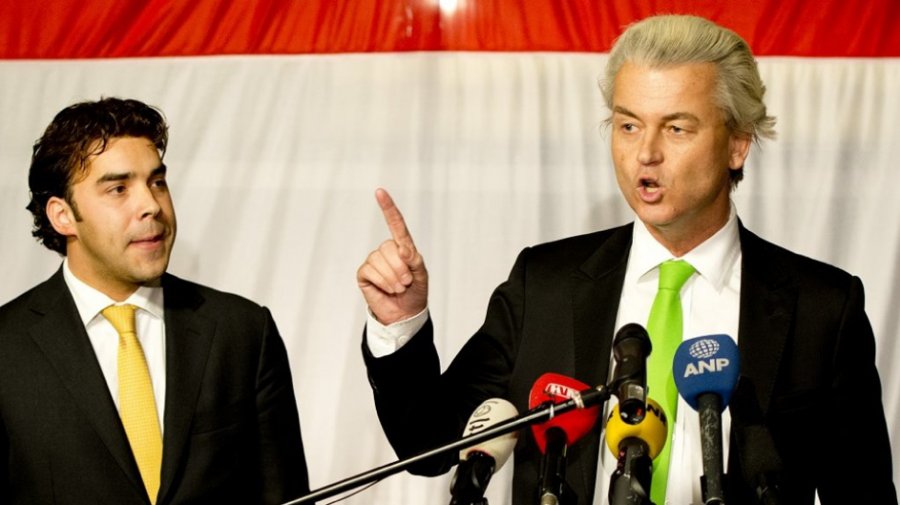
Figure 1. Geert Wilders during his controversy-sparking statement on the 19th of March 2014.
This type of right-wing populism has established itself as a real factor in Dutch politics (Faber, 2017), and it has seriously changed voting behavior. Even after last year’s unexpected victory of a different right-wing populist party, i.e. Forum for Democracy (FvD), Wilders’ party remained strong in large parts of Limburg (see Figure 2). This illustrates how Limburg still does not really represent a place full of acceptance, in which migrants are received with open arms. Of course, this is not to say that all Limburgians are xenophobic! However, we could say that there are still quite some people who are a bit skeptical about migrants.
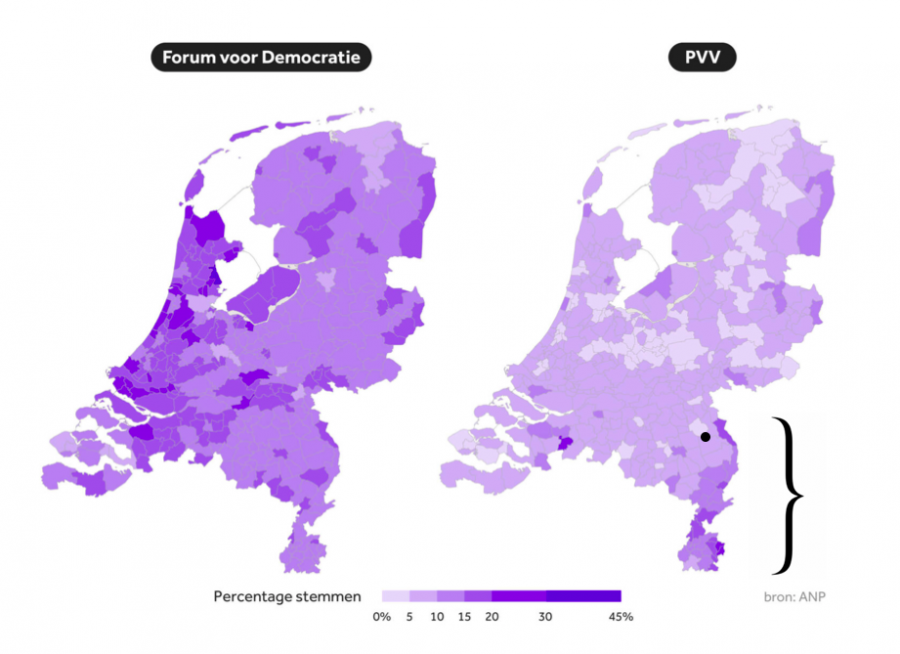
Figure 2. Map of voting behavior in the Netherlands (NOS, 2019). The bracket indicates the province of Limburg and the black dot indicates the city of Venray.
Superdiversity
Despite the (racially) discriminatory undertones in people’s voting behavior, Limburg remains a place of cultural and ethnic diversity. We can find Asian restaurants, Turkish food trucks and Polish supermarkets (see Figure 3) almost everywhere. It is these kinds of "resident infrastructures" that owe their existence to migration and give the world its superdiverse outlook (Blommaert, 2010; Vertovec, 2007). Without migration, many of us would not be enjoying the kebabs of our Turkish fellow citizens.
The superdiversity of ethnic backgrounds in these regions also comes through quite vividly during the yearly celebration of carnival. Polish, Moroccan, Turkish and other ethnic minorities stay at home or go on a short vacation during the celebration, whereas other locals dress up and connect with fellow carnival celebrators. The gap is noticeable and does not promote the integration of migrants.
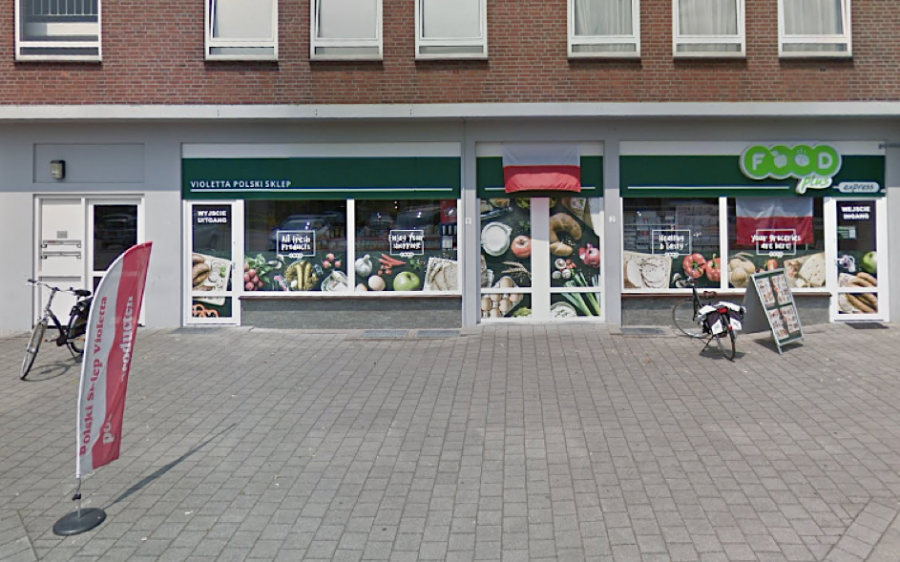
Figure 3. Polski Sklep Violetta: a Polish supermarket in the Limburgian city of Venray.
Therefore, when I heard that the famous Turkish kebab man of Venray (Northern-Limburg) had written a carnival song in dialect and was going to perform it during carnival, I was amazed. Not only had the man, Bülent Arpaci (see Figure 4), learned to speak Dutch in the few years he had lived in Limburg, but he had also learned the local dialect, which many of the town’s inhabitants do not even master.
Moreover, Arpaci infused his carnival song with Turkish tones, instruments and vocals, making it a bit global. Against this background, the questions this article sets out to answer are (1) whether Arpaci’s carnival song changed the local celebration of carnival, and (2) whether the song resulted in local carnival celebrators fully incorporating the man as “one of their own”.
In what follows, the events leading up to the song’s release and clip shoot will be discussed. A personal interview with Arpaci will provide some insight into his own thoughts and feelings on the matter. Further, the mediatized clip shoot and the online reactions on the song’s video clip and related social media posts will be analyzed: were people’s reactions mainly positive or negative?
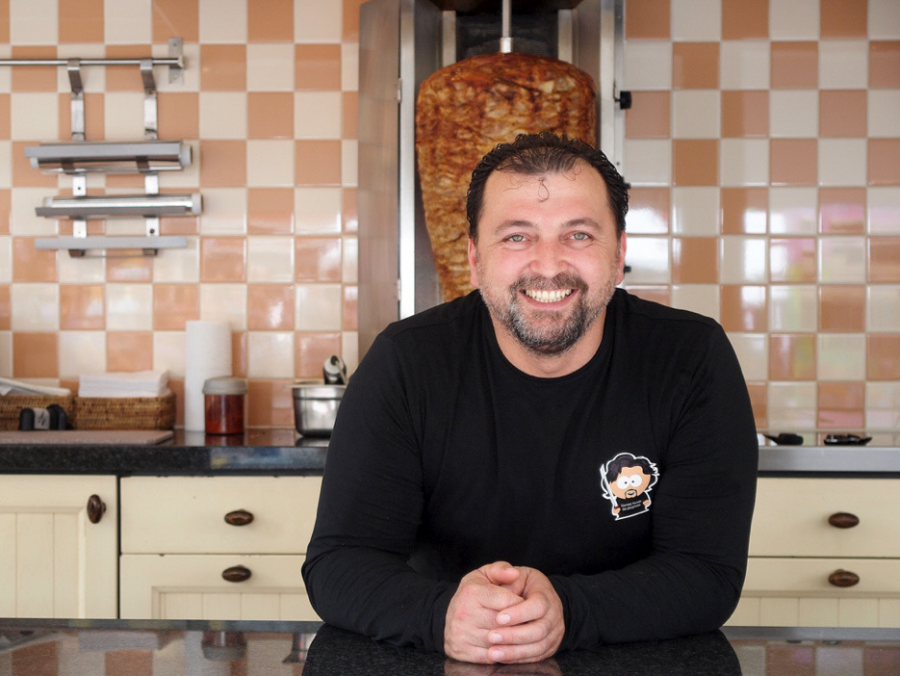
Figure 4. Bülent Arpaci, owner of mobile food truck Bülent Kebab & Kip van ’t Spit (kebabs & chicken from the spit) in Venray, Northern Limburg.
Carnival through the eyes of a Turkish immigrant
Bülent Arpaci fell in love with carnival only four months after he had immigrated to the Netherlands, which was nineteen years ago. Though he did not understand anything of what was going on, he was intrigued and open to learn about it. It was his curiosity that led him into a café one night. Arpaci, who at the time did not speak a single word of Dutch, said the following in an interview with local newspaper De Limburger (2019): “It was amazing. There were so many people who all did their best to talk to me even though I only spoke a little German!”
Nowadays, Arpaci celebrates carnival every year. As he owns a very popular mobile food truck, which has really become a staple of the town’s market, he found himself too busy to celebrate carnival in recent years. But in 2019, he made the decision to turn all this around. "It actually started as a joke", he says. "During the beer festival in Venray I told others about my idea to write a carnival song. Before I knew it, we were already making up song lyrics with a group of people." (Seuren, 2019)
"The singing kebab man from Venray. Integration in optima forma."
Still under the impression that the whole idea was just a joke, Arpaci bumped into local carnival singer Ramon Barents the next day (Figure 5). Barents was very excited: "When I heard the title and what the song was about, I knew Bülent was holding a carnival hit. And the rest also fits great: the singing kebab man from Venray. Integration in optima forma.” (Seuren, 2019)
The song is about Arpaci’s mother-in-law and how she always complains about her back pain. It is infused with Turkish sounds, instruments and even some vocal elements, making it a rather unique blend of traditional Turkish music and traditional carnival music. In an interview, Arpaci did admit that writing a song in dialect was challenging as the dialect generally deviates quite a lot from standard Dutch. But luckily, he got help from a local carnival enthusiast. Even before releasing the song and video clip, the man’s year already looked like it could not go any better. "Ever since I was a little boy, I dreamed of becoming a movie star", he confessed. "I'm still waiting, but with this song and my own clip, a piece of that dream comes true." (Seuren, 2019)
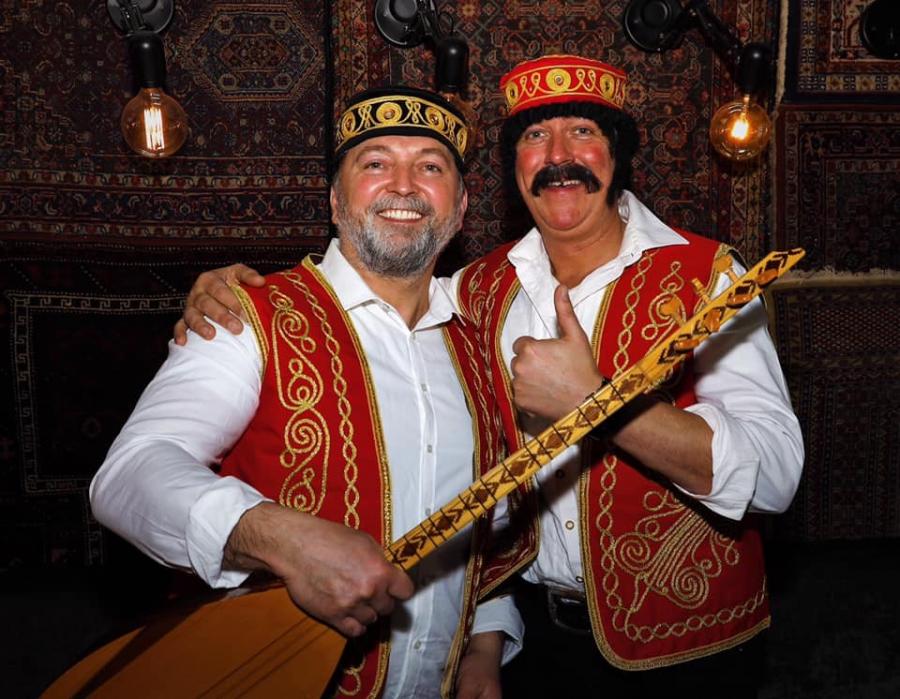
Figure 5. Bülent Arpaci and local carnival singer Ramon Barents in their full (traditionally Turkish) carnival costumes.
During the making of the video clip, which was broadcasted by local news channel Peel en Maas TV, we see Arpaci stepping out of a white limousine in front of his famous food truck in Venray. Dozens of locals are chanting “Bülent! Bülent! Bülent!” as he steps onto his podium and performs his song with singer Barents. The audience seems to already know the words to the song, and we see people of all ages dancing. Arpaci is having the time of his life. In a short post-interview, he is almost unable to find the words that express his joy. Smiling ear to ear, he finally says: “Thank you, Venray, all of you!”
Reactions to Pien Ien Miene Knoak
Of course, people also reacted to the song on various social media platforms. When looking at the comment section of the official video on YouTube - which I highly recommend watching - we see only positive feedback coming from locals. People are really applauding Arpaci’s efforts (and kebabs). One person even asked for a signed picture through a YouTube comment (see Figure 6). Interestingly, the most liked comment is from content creator Rick Vermeulen, who is also from the township of Venray. With over 106,000 subscribers on his channel, he is quite well-known in the Netherlands. Also, Vermeulen has made some very successful carnival-related videos on YouTube himself.
Arpaci’s music video got over 10,200 views and 113 likes, which is a lot in Limburgian terms. When looking at Arpaci’s Instagram posts involving the carnival song, we see the same kind of comments (though here, we see a mix of Dutch and Turkish comments). Once again, none of them are negative in any way (see Figure 7). The nature of the online reactions to the song correspond with how the live audience reacted to Arpaci’s performance during the clip shoot. People are genuinely enjoying themselves and the performance. Everybody, including Arpaci, is smiling.
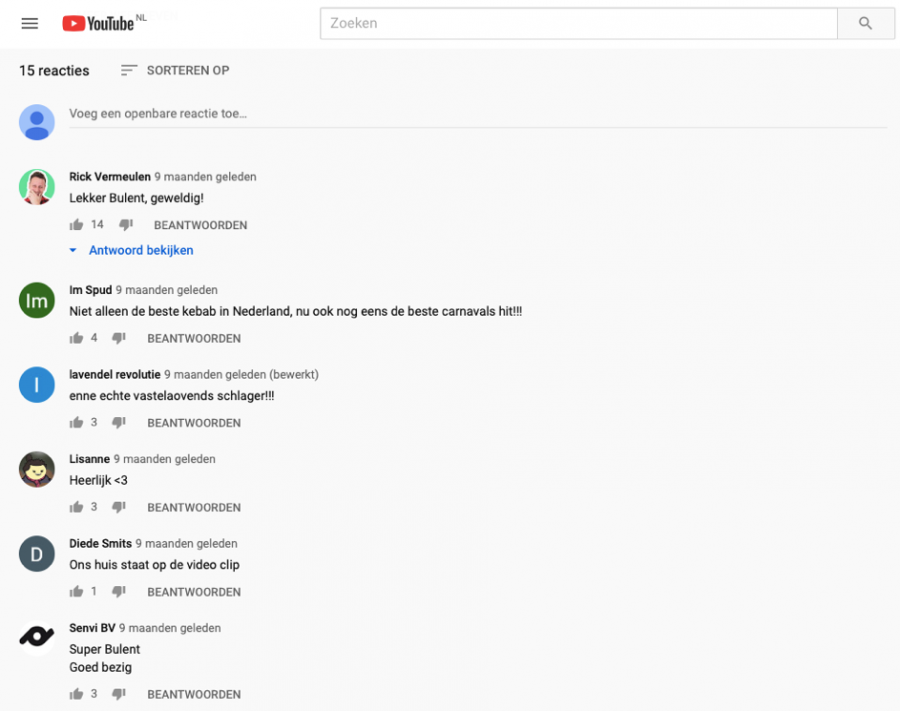
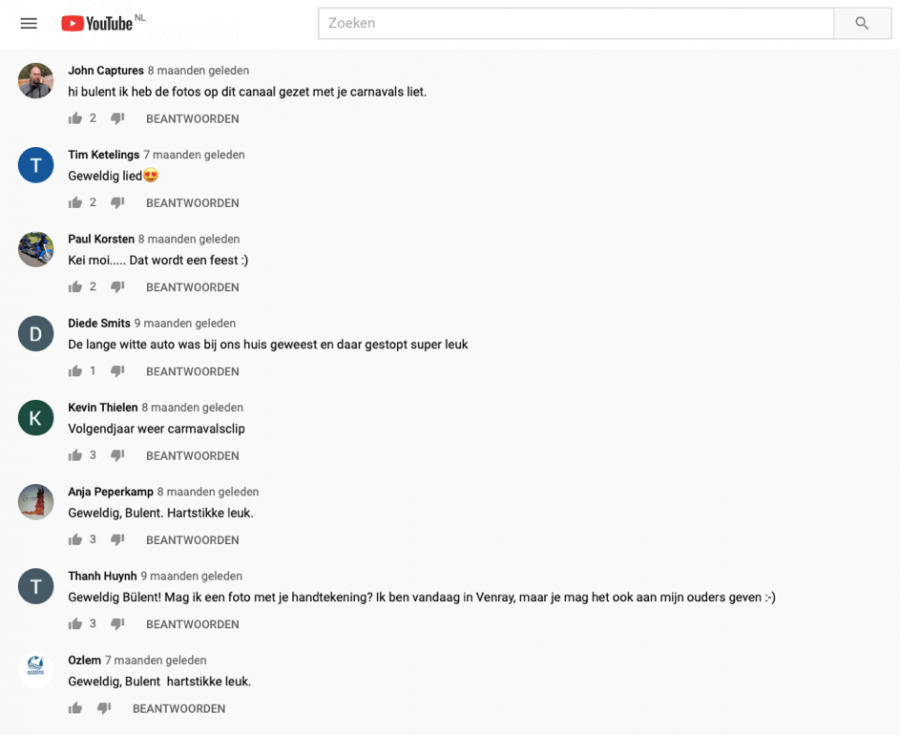
Figure 6. Only positive comments coming from locals on Arpaci's YouTube music video.
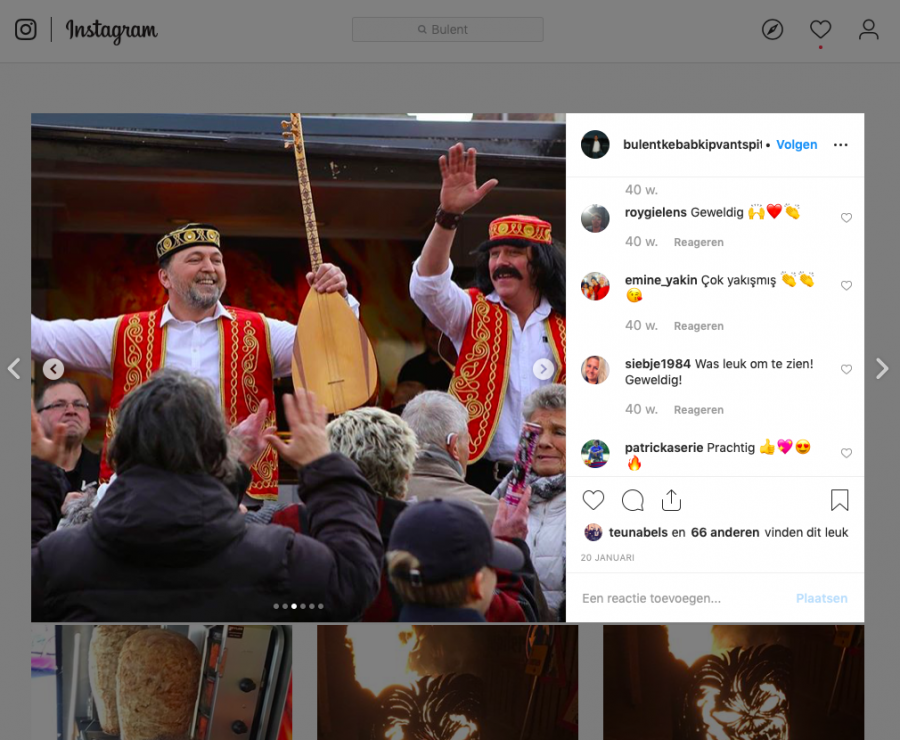
Figure 7. Positive reactions on Arpaci’s Instagram posts, coming from both Dutch and Turkish fans.
A Turkish carnival?
All in all, we can conclude that the reactions to Arpaci’s carnival song were exceptionally positive. Needless to say, the song became an absolute hit and was played throughout the whole celebration of carnival. It seems that even in the periphery, carnival can still not escape the effects of globalization and migration (Wang et al., 2013). Hence, in Venray, we encounter a special mix of, on the one hand, people that strongly adhere to old, local traditions and, on the other, people that come from all around of the globe.
In the specific case of Bülent Arpaci, we see an extremely well-integrated immigrant playing a role in and even contributing to a very particular local tradition. Through his contribution, Arpaci made carnival a bit more global. He did so by infusing traditional carnival with Turkish elements, resulting in a song that is both Limburgian and Turkish in character. This goes to show that when people are overwhelmed by local traditions, such as carnival, they can also find refuge in these traditions. And even though having different languages is often seen as a problem in the context of migration, it can actually serve as an opportunity as well.
"Integration is fantastic, and Bülent is a great example of that."
So far, I have explained that the case of Bülent Arpaci is an extremely special one, in which we see a specific dynamic between local culture and global influences. I started off by explaining that Limburgians are typically not classified as “pro-immigration”, especially if we look at their past voting behavior, which is rather right-leaning and populist (Faber, 2017). Still, Limburg remains a place of cultural superdiversity. Migrants form a huge part of the Limburgian landscape and society. Together with other people’s strong adherence to local identity (e.g. through dialects) and Dutch traditions, this can lead to inequality of cultural experiences, which is the case with carnival.
There is a gap between those that celebrate carnival and those who do not. As an immigrant, Bülent Arpaci made a brave first step to participate in the local tradition of celebrating carnival. Though we cannot say that Arpaci changed carnival forever, as one song can only do so much, we can definitely say that the locals absolutely loved his efforts and fully incorporated the man as “one of their own”. This is also reflected in the song’s video clip: many locals are applauding and chanting the man’s name as he steps out of a limousine. These people were not casted; they were just on their way to the shops. They all knew the man personally. I know for sure, because I was in that crowd too.
Participating in local traditions could play a very large role in furthering the integration of migrants. As singer Barents said in a short interview with Peel en Maas TV (2019): “The Turkish community is not really part of carnival yet, but integration is fantastic, and Bülent is a great example of that.” Maybe in the coming years, we will see more and more Turkish people in Venray celebrating carnival and enjoying the holiday. Even though it was Arpaci who initiated the whole event in this case (and not the locals themselves), it may have become more visible that Limburgians can be very open to and accepting of immigrants. This leaves us hopeful for a future in which integration advances even further.
References
Blommaert, J. (2010). The sociolinguistics of globalization. Cambridge, England: Cambridge University Press.
Cornips, L., & De Rooij, V. (2015). Belonging through languagecultural practices in the periphery: the politics of carnival in the Dutch province of Limburg. Anthropological Journal of European Cultures, 24(1), 83-101.
Faber, S. (2017, February 21). Why the Dutch are drawn to right-wing populist Geert Wilders. The Nation. Retrieved from: https://www.thenation.com
Kroet, C. (2016, September 12). Geert Wilders guilty of incitement. Politico. Retrieved from: https://www.politico.eu
NRC Handelsblad. (2014, March 20). Wilders: Ik regel minder Marokkanen [Press release]. Retrieved from: https://www.nrc.nl/nieuws/2014/03/20/wilders-ik-regel-minder-marokkanen-...
Seuren, E. (2019, January 14). “Kebabman van Venray” komt met carnavalsschlager in het dialect. De Limburger. Retrieved from: https://www.limburger.nl
Vertovec, S. (2007). Super-diversity and its implications. Ethnic and Racial Studies, 30(6), 1024-1054.
Wang, X., Spotti, M., Juffermans, K., Cornips, L., Kroon, S., & Blommaert, J. (2013). Globalization in the margins; Toward a re-evaluation of language and mobility. Applied Linguistics Review, 5(1), 23-44.